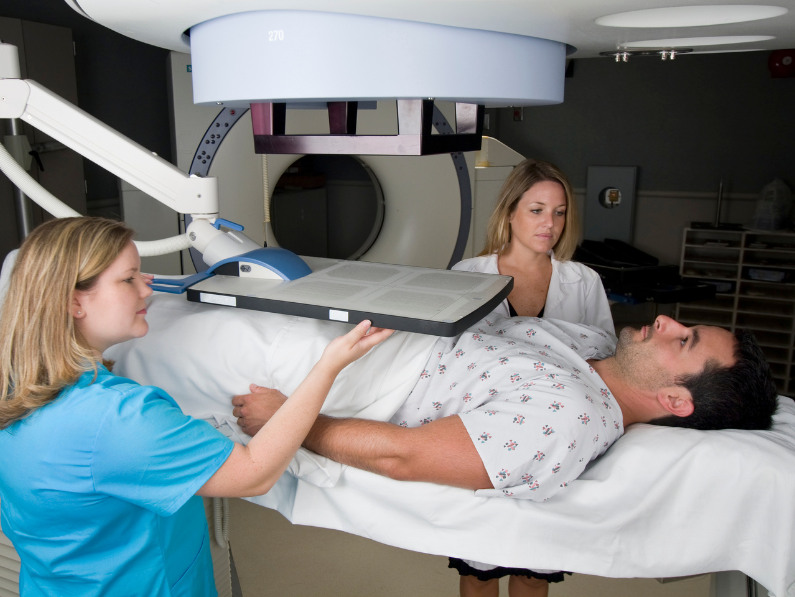Prostate cancer is the most common type of cancer among people with prostates, except for skin cancer. In 2023, it was estimated that over 288,000 people in the United States would be diagnosed with prostate cancer. This type of cancer is typically slow-growing, but it can be debilitating if left untreated for long periods of time. Because of this, early detection and effective treatment is key in achieving successful long-term survivability.
IMRT, or Intensity-Modulated Radiation Therapy, is a type of cancer treatment that has proven to be highly effective in reducing the number of cancer cells present in prostate cancer patients. IMRT for prostate cancer uses controlled doses of highly targeted radiation to kill cancer cells in a person’s prostate, reducing or even completely eliminating the chances of further spreading or growth.
For more information about prostate cancer, recurrent prostate cancer, types of treatment, and more, visit our FAQ page.
Early Detection Is Key
In general, the earlier that a prostate cancer is detected, the higher chance there is for successful treatment and long-term survivability. Because of this, it’s important to undergo regular screenings for prostate cancer from a trusted healthcare professional, and to inform your health team if you suspect you may have prostate cancer or have a family history of prostate cancer. Prostate cancer is typically very slow moving, and though there are many effective forms of treatment, it should still be caught as early as possible to reduce the possibility of further growth or spread to other areas of the body.
The 5-year survival rate for prostate cancer patients, in which the cancer was discovered before it has spread, or in which it has only spread to some of the nearby areas, is over 99%. This means that if prostate cancer is treated before it can spread, a patient has roughly the same life-expectancy as anyone else, including non-cancer patients. Early detection is key in maintaining a full life-expectancy, however, as if left untreated for long periods of time, prostate cancer can spread elsewhere in the body, affecting other areas and potentially reducing a patient’s lifespan.
Using Image Guided Radiation Therapy (IGRT) for Prostate Cancer Treatment
Image Guided Radiation Therapy, or IGRT, is imaging used in conjunction with radiation therapy to create a highly precise prostate cancer treatment that damages or kills cancer cells and minimize the amount of excess radiation absorbed by the surrounding areas. This can greatly reduce or eliminate the number of cancer cells present in a prostate cancer patient, while exposing them to the minimum amount of risk to some of the side effects that come from radiation.
The optimal treatment plan for prostate cancer involves a combination of Image Guided Radiation Therapy and Intensity-Modulated Radiation Therapy. At ICC, each patient has a customized treatment plan designed to enable the best possible results for their individual cancer case.
Detecting Prostate Cancer
Prostate cancer can be detected in several ways. Prostate specific antigen (PSA) level testing or a digital rectal exam (DRE) performed by a trusted healthcare professional are the two most common ways of diagnosing any type of prostate abnormalities. Though these tests are often indicative of prostate cancer, this isn’t always the case. Prostates typically enlarge as a person grows older and can also be enlarged because of certain medications, inflammation, exercise (such as riding a bike), or sexual activity. Receiving only a PSA test or DRE is not by itself definitive. This is why, for best results, a patient should combine multiple forms of testing for maximum accuracy.
At-Home Prostate Specific Antigen (PSA) Tests
Typically, the most accurate way of detecting prostate cancer is by monitoring a patient’s prostate specific antigen (PSA) levels. PSA is a substance that is made by the prostate. An elevated PSA level, as indicated by a PSA test, can be indicative of prostate cancer and may be a sign that a patient needs to seek treatment. At-home PSA tests are an easily accessible and cost-effective way of monitoring a person’s PSA levels.
However, at-home PSA tests are only so accurate. An elevated PSA level is not necessarily indicative of prostate cancer, and at-home PSA testing is not able to determine why a PSA level is elevated. Combining at-home PSA testing with a digital rectal exam from a healthcare professional, along with a possible biopsy (if determined to be necessary), ensures a higher level of accuracy. Patients can purchase PSA testing kits online or from any major drug store, and then should make an appointment with their doctor or health professional if they find the results to be abnormal.
In-Office Digital Rectal Exams
Other ways of detecting prostate cancer include visiting a trusted health professional for a digital rectal exam (DRE). A DRE involves a doctor inserting a lubricated, gloved finger into the anus to gently inspect for any potential signs of prostate cancer. Potential signs could include (but are not limited to) bumps, hard areas, and particular spots of irritation or inflammation. Usually, the exam performed is brief and should include minimum discomfort for the patient. Increased discomfort can occur in some patients that have hemorrhoids or other abnormalities in and around the anus or lower rectum. Speak to a healthcare professional before a DRE if you’ve had past issues with hemorrhoids and ask if there are any accommodations that can be made to minimize your discomfort.
If a physician does find abnormalities in a DRE, especially in conjunction with elevated levels in PSA testing, they will likely recommend a biopsy of the prostate so further testing can be performed. Once further testing has been completed, your health team will review your results with you and decide whether further testing or treatment is necessary.
Sources

